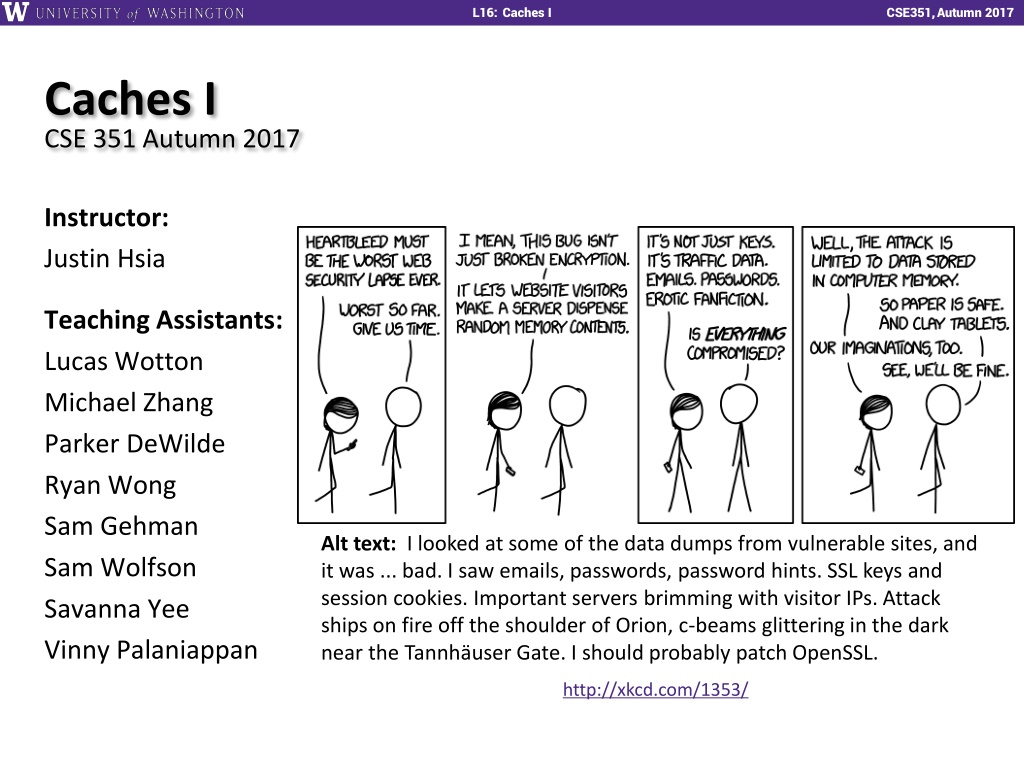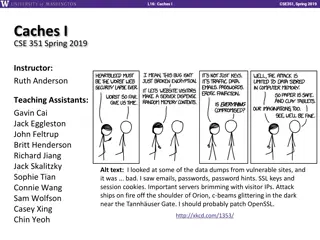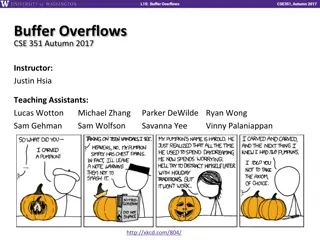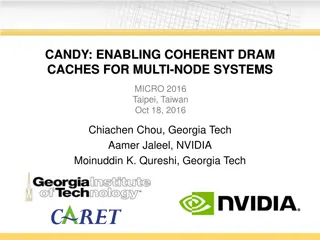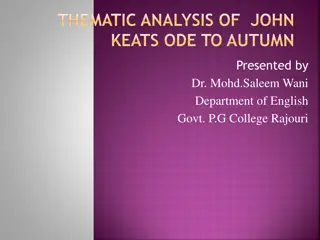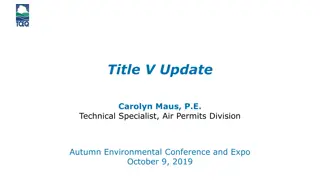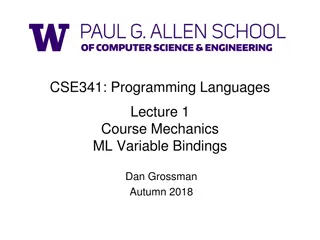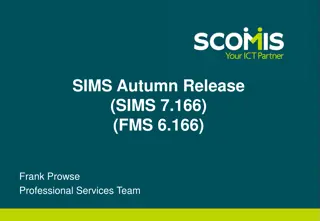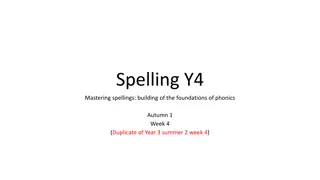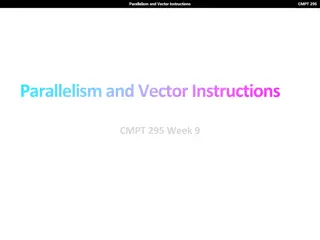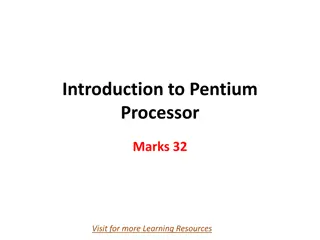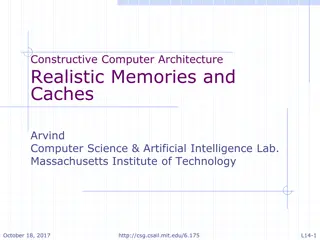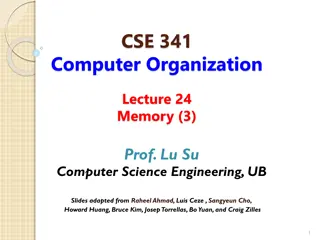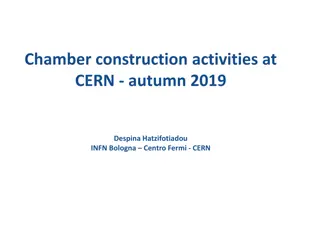CSE351 Autumn 2017: Caches Instructor and TA Information
The content provides information about the CSE351 course on caches for Autumn 2017, including details about the instructor, teaching assistants, administrative updates, midterm policies, course roadmap, units and prefixes, mnemonic techniques, and execution time analysis. It also includes important deadlines and instructions for students.
Download Presentation

Please find below an Image/Link to download the presentation.
The content on the website is provided AS IS for your information and personal use only. It may not be sold, licensed, or shared on other websites without obtaining consent from the author. Download presentation by click this link. If you encounter any issues during the download, it is possible that the publisher has removed the file from their server.
E N D
Presentation Transcript
L16: Caches I CSE351, Autumn 2017 Caches I CSE 351 Autumn 2017 Instructor: Justin Hsia Teaching Assistants: Lucas Wotton Michael Zhang Parker DeWilde Ryan Wong Sam Gehman Sam Wolfson Savanna Yee Vinny Palaniappan Alt text: I looked at some of the data dumps from vulnerable sites, and it was ... bad. I saw emails, passwords, password hints. SSL keys and session cookies. Important servers brimming with visitor IPs. Attack ships on fire off the shoulder of Orion, c-beams glittering in the dark near the Tannh user Gate. I should probably patch OpenSSL. http://xkcd.com/1353/
L16: Caches I CSE351, Autumn 2017 Administrivia Homework 3 due tonight Lab 3 due next Thursday (11/9) Midterm grades released tomorrow Regrade requests done on Gradescope and due Wednesday (11/8) Midterm Clobber Policy Final will be cumulative (half midterm, half post-midterm) If you perform better on the midterm portion of the final, you replace your midterm score! MT stddev FMT stddev+ MT mean Replacement score = FMT score FMT avg 2
L16: Caches I CSE351, Autumn 2017 Roadmap C: Memory & data Integers & floats x86 assembly Procedures & stacks Executables Arrays & structs Memory & caches Processes Virtual memory Memory allocation Java vs. C Java: Car c = new Car(); c.setMiles(100); c.setGals(17); float mpg = c.getMPG(); car *c = malloc(sizeof(car)); c->miles = 100; c->gals = 17; float mpg = get_mpg(c); free(c); Assembly language: get_mpg: pushq %rbp movq %rsp, %rbp ... popq %rbp ret OS: Machine code: 0111010000011000 100011010000010000000010 1000100111000010 110000011111101000011111 Computer system: 3
L16: Caches I CSE351, Autumn 2017 Aside: Units and Prefixes Here focusing on large numbers (exponents > 0) Note that 103 210 SI prefixes are ambiguous if base 10 or 2 IEC prefixes are unambiguously base 2 4
L16: Caches I CSE351, Autumn 2017 How to Remember? Will be given to you on Final reference sheet Mnemonics There unfortunately isn t one well-accepted mnemonic But that shouldn t stop you from trying to come with one! Killer Mechanical Giraffe Teaches Pet, Extinct Zebra to Yodel Kirby Missed Ganondorf Terribly, Potentially Exterminating Zelda and Yoshi xkcd: Karl Marx Gave The Proletariat Eleven Zeppelins, Yo https://xkcd.com/992/ Post your best on Piazza! 5
L16: Caches I CSE351, Autumn 2017 How does execution time grow with SIZE? int array[SIZE]; int sum = 0; for (int i = 0; i < 200000; i++) { for (int j = 0; j < SIZE; j++) { sum += array[j]; } } Time Plot SIZE 6
L16: Caches I CSE351, Autumn 2017 Actual Data 45 40 35 30 Time 25 20 15 10 5 0 0 2000 4000 6000 8000 10000 SIZE 7
L16: Caches I CSE351, Autumn 2017 Making memory accesses fast! Cache basics Principle of locality Memory hierarchies Cache organization Program optimizations that consider caches 8
L16: Caches I CSE351, Autumn 2017 Processor-Memory Gap 1989 first Intel CPU with cache on chip 1998 Pentium III has two cache levels on chip Proc 55%/year (2X/1.5yr) 10000 1000 Performance Processor-Memory Performance Gap (grows 50%/year) 100 Moore s Law 10 DRAM 7%/year (2X/10yrs) 1 Year 9
L16: Caches I CSE351, Autumn 2017 Problem: Processor-Memory Bottleneck Processor performance doubled about every 18 months Bus latency / bandwidth evolved much slower Main Memory CPU Reg Core 2 Duo: Can process at least 256 Bytes/cycle Core 2 Duo: Bandwidth 2 Bytes/cycle Latency 100-200 cycles (30-60ns) Problem: lots of waiting on memory cycle: single machine step (fixed-time) 10
L16: Caches I CSE351, Autumn 2017 Problem: Processor-Memory Bottleneck Processor performance doubled about every 18 months Bus latency / bandwidth evolved much slower Main Memory CPU Reg Cache Core 2 Duo: Can process at least 256 Bytes/cycle Core 2 Duo: Bandwidth 2 Bytes/cycle Latency 100-200 cycles (30-60ns) Solution: caches cycle: single machine step (fixed-time) 11
L16: Caches I CSE351, Autumn 2017 Cache Pronunciation: cash We abbreviate this as $ English: A hidden storage space for provisions, weapons, and/or treasures Computer: Memory with short access time used for the storage of frequently or recently used instructions (i-cache/I$) or data (d-cache/D$) More generally: Used to optimize data transfers between any system elements with different characteristics (network interface cache, I/O cache, etc.) 12
L16: Caches I CSE351, Autumn 2017 General Cache Mechanics Smaller, faster, more expensive memory Caches a subset of the blocks Cache 7 9 14 3 Data is copied in block-sized transfer units Memory Larger, slower, cheaper memory. Viewed as partitioned into blocks 0 1 2 3 4 5 6 7 8 9 10 11 12 13 14 15 13
L16: Caches I CSE351, Autumn 2017 General Cache Concepts: Hit Data in block b is needed Request: 14 Block b is in cache: Hit! Cache 7 9 14 14 3 Data is returned to CPU Memory 0 1 2 3 4 5 6 7 8 9 10 11 12 13 14 15 14
L16: Caches I CSE351, Autumn 2017 General Cache Concepts: Miss Data in block b is needed Request: 12 Block b is not in cache: Miss! Cache 7 9 12 14 3 Block b is fetched from memory Request: 12 12 Block b is stored in cache Placement policy: determines where b goes Replacement policy: determines which block gets evicted (victim) Memory 0 1 2 3 4 5 6 7 8 9 10 11 12 12 13 14 15 Data is returned to CPU 15
L16: Caches I CSE351, Autumn 2017 Why Caches Work Locality: Programs tend to use data and instructions with addresses near or equal to those they have used recently 16
L16: Caches I CSE351, Autumn 2017 Why Caches Work Locality: Programs tend to use data and instructions with addresses near or equal to those they have used recently block Temporal locality: Recently referenced items are likely to be referenced again in the near future 17
L16: Caches I CSE351, Autumn 2017 Why Caches Work Locality: Programs tend to use data and instructions with addresses near or equal to those they have used recently block Temporal locality: Recently referenced items are likely to be referenced again in the near future Spatial locality: Items with nearby addresses tend to be referenced close together in time block How do caches take advantage of this? 18
L16: Caches I CSE351, Autumn 2017 Example: Any Locality? sum = 0; for (i = 0; i < n; i++) { sum += a[i]; } return sum; Data: Temporal: Spatial: sum referenced in each iteration array a[]accessed in stride-1 pattern Instructions: Temporal: Spatial: cycle through loop repeatedly reference instructions in sequence 19
L16: Caches I CSE351, Autumn 2017 Locality Example #1 int sum_array_rows(int a[M][N]) { int i, j, sum = 0; for (i = 0; i < M; i++) for (j = 0; j < N; j++) sum += a[i][j]; return sum; } 20
L16: Caches I CSE351, Autumn 2017 Locality Example #1 M = 3, N=4 a[0][0] a[0][1] int sum_array_rows(int a[M][N]) { int i, j, sum = 0; a[0][2] a[0][3] a[1][0] a[1][1] a[1][2] a[1][3] for (i = 0; i < M; i++) for (j = 0; j < N; j++) sum += a[i][j]; a[2][0] a[2][1] a[2][2] a[2][3] Access Pattern: stride = ? 1) a[0][0] 2) a[0][1] 3) a[0][2] 4) a[0][3] 5) a[1][0] 6) a[1][1] 7) a[1][2] 8) a[1][3] 9) a[2][0] 10) a[2][1] 11) a[2][2] 12) a[2][3] return sum; } Layout in Memory a [0] [0] a [0] [1] a a [0] [3] a [1] [0] a [1] [1] a [1] [2] a [1] [3] a [2] [0] a [2] [1] a [2] [2] a [2] [3] [0] [2] 76 92 108 Note: 76 is just one possible starting address of array a 21
L16: Caches I CSE351, Autumn 2017 Locality Example #2 int sum_array_cols(int a[M][N]) { int i, j, sum = 0; for (j = 0; j < N; j++) for (i = 0; i < M; i++) sum += a[i][j]; return sum; } 22
L16: Caches I CSE351, Autumn 2017 Locality Example #2 M = 3, N=4 a[0][0] a[0][1] int sum_array_cols(int a[M][N]) { int i, j, sum = 0; a[0][2] a[0][3] a[1][0] a[1][1] a[1][2] a[1][3] for (j = 0; j < N; j++) for (i = 0; i < M; i++) sum += a[i][j]; a[2][0] a[2][1] a[2][2] a[2][3] Access Pattern: stride = ? 1) a[0][0] 2) a[1][0] 3) a[2][0] 4) a[0][1] 5) a[1][1] 6) a[2][1] 7) a[0][2] 8) a[1][2] 9) a[2][2] 10) a[0][3] 11) a[1][3] 12) a[2][3] return sum; } Layout in Memory a [0] [0] a [0] [1] a a [0] [3] a [1] [0] a [1] [1] a [1] [2] a [1] [3] a [2] [0] a [2] [1] a [2] [2] a [2] [3] [0] [2] 76 92 108 23
L16: Caches I CSE351, Autumn 2017 Locality Example #3 int sum_array_3D(int a[M][N][L]) { int i, j, k, sum = 0; What is wrong with this code? for (i = 0; i < N; i++) for (j = 0; j < L; j++) for (k = 0; k < M; k++) sum += a[k][i][j]; How can it be fixed? return sum; } a[2][0][0] a[2][0][1] a[2][0][2] a[2][0][3] a[1][0][0] a[1][0][1] a[1][0][2] a[1][0][3] a[0][0][0] a[0][0][1] a[0][0][2] a[0][0][3] a[2][1][0] a[2][1][1] a[2][1][2] a[2][1][3] a[1][1][0] a[1][1][1] a[1][1][2] a[1][1][3] a[0][1][0] a[0][1][1] a[0][1][2] a[0][1][3] a[2][2][0] a[2][2][1] a[2][2][2] a[2][2][3] a[1][2][0] a[1][2][1] a[1][2][2] a[1][2][3] a[0][2][0] a[0][2][1] a[0][2][2] a[0][2][3] m = 2 m = 1 m = 0 24
L16: Caches I CSE351, Autumn 2017 Locality Example #3 int sum_array_3D(int a[M][N][L]) { int i, j, k, sum = 0; What is wrong with this code? for (i = 0; i < N; i++) for (j = 0; j < L; j++) for (k = 0; k < M; k++) sum += a[k][i][j]; How can it be fixed? return sum; } Layout in Memory (M = ?, N = 3, L = 4) a [0] [0] [0] a [0] [0] [1] a [0] [0] [2] a [0] [0] [3] a [0] [1] [0] a [0] [1] [1] a [0] [1] [2] a [0] [1] [3] a [0] [2] [0] a [0] [2] [1] a [0] [2] [2] a [0] [2] [3] a [1] [0] [0] a [1] [0] [1] a [1] [0] [2] a [1] [0] [3] a [1] [1] [0] a [1] [1] [1] a [1] [1] [2] a [1] [1] [3] a [1] [2] [0] a [1] [2] [1] a [1] [2] [2] a [1] [2] [3] 76 92 108 124 140 156 172 25
L16: Caches I CSE351, Autumn 2017 Cache Performance Metrics Huge difference between a cache hit and a cache miss Could be 100x speed difference between accessing cache and main memory (measured in clock cycles) Miss Rate (MR) Fraction of memory references not found in cache (misses / accesses) = 1 - Hit Rate Hit Time (HT) Time to deliver a block in the cache to the processor Includes time to determine whether the block is in the cache Miss Penalty (MP) Additional time required because of a miss 26
L16: Caches I CSE351, Autumn 2017 Cache Performance Two things hurt the performance of a cache: Miss rate and miss penalty Average Memory Access Time (AMAT): average time to access memory considering both hits and misses AMAT = Hit time + Miss rate Miss penalty (abbreviated AMAT = HT + MR MP) 99% hit rate twice as good as 97% hit rate! Assume HT of 1 clock cycle and MP of 100 clock cycles 97%: AMAT = 99%: AMAT = 27
L16: Caches I CSE351, Autumn 2017 Peer Instruction Question Processor specs: 200 ps clock, MP of 50 clock cycles, MR of 0.02 misses/instruction, and HT of 1 clock cycle AMAT = Which improvement would be best? Vote at http://PollEv.com/justinh A. 190 ps clock B. Miss penalty of 40 clock cycles C. MR of 0.015 misses/instruction 28
L16: Caches I CSE351, Autumn 2017 Can we have more than one cache? Why would we want to do that? Avoid going to memory! Typical performance numbers: Miss Rate L1 MR = 3-10% L2 MR = Quite small (e.g. < 1%), depending on parameters, etc. Hit Time L1 HT = 4 clock cycles L2 HT = 10 clock cycles Miss Penalty P = 50-200 cycles for missing in L2 & going to main memory Trend: increasing! 29
L16: Caches I CSE351, Autumn 2017 An Example Memory Hierarchy 5-10 s <1 ns registers on-chip L1 cache (SRAM) 1 ns Smaller, faster, costlier per byte off-chip L2 cache (SRAM) 5-10 ns 1-2 min 15-30 min main memory (DRAM) 100 ns Larger, slower, cheaper per byte 150,000 ns 31 days SSD local secondary storage (local disks) 10,000,000 ns (10 ms) Disk 66 months = 5.5 years remote secondary storage (distributed file systems, web servers) 1-150 ms 1 - 15 years 30
L16: Caches I CSE351, Autumn 2017 Summary Memory Hierarchy Successively higher levels contain most used data from lower levels Exploits temporal and spatial locality Caches are intermediate storage levels used to optimize data transfers between any system elements with different characteristics Cache Performance Ideal case: found in cache (hit) Bad case: not found in cache (miss), search in next level Average Memory Access Time (AMAT) = HT + MR MP Hurt by Miss Rate and Miss Penalty 31
